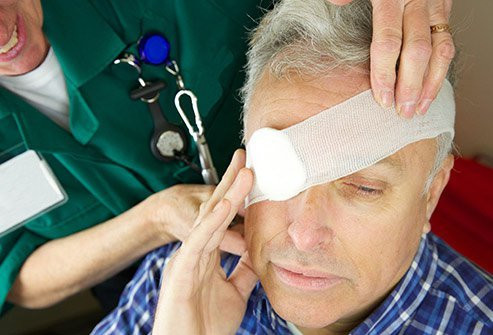Definisi
Kontusio paru adalah suatu kondisi dimana terjadi kerusakan pada jaringan paru baik secara langsung atau tidak langsung akibat trauma pada dada, yang ditandai dengan pembengkakan atau memar pada alveoli (kantung udara di paru). Kerusakan pada jaringan paru ini terjadi tanpa kerusakan nyata pada struktur paru, contohnya adalah robekan atau luka jaringan paru. Akibat memar atau pembengkakan yang terjadi, paru dapat kehilangan sebagian fungsi normalnya.
Kontusio paru merupakan jenis cedera paru yang paling sering terjadi pada penderita trauma dada. Kondisi ini sering terjadi bersamaan dengan trauma lainnya, seperti kontusio jantung, trauma kepala, robeknya diafragma, limpa, aorta, jantung, dan usus. Cedera pada dada bisa terjadi akibat benda tajam atau benda tumpul. Komplikasi paling berat dari kontusio adalah ruptur pada saluran napas atau paru.
Penyebab
Kontusio paru biasanya disebabkan oleh trauma tumpul atau syok akibat trauma benda tajam pada dada. Kontusio biasanya melibatkan benturan energi tinggi pada dada dan umumnya ditemukan pada:
- Kecelakaan lalu lintas
- Kecelakaan kerja
- Jatuh dari ketinggian
- Penekanan dada oleh benda yang berat
- Pukulan pada dada secara tiba-tiba, biasanya pada kasus kekerasan fisik
- Ledakan
- Cedera akibat olahraga
Kontusio biasanya terjadi pada lokasi benturan. Kecepatan dari impuls dan tingkat kompresi (tekanan) benturan merupakan faktor terpenting yang menyebabkan kerusakan jaringan paru. Kerusakan yang timbul berupa robeknya alveoli dan pembuluh darah kecil (kapiler) di area paru, dan mengakibatkan penumpukan darah serta cairan lainnya di dalam jaringan paru. Pertama-tama, darah akan muncul pada area paru yang terkena, lalu beberapa jam kemudian diikuti dengan pembengkakan pada area yang terkena dan di sekitarnya.
Jaringan paru juga akan kehilangan elastisitasnya, membuat paru sulit mengembang dan menjalankan fungsi pernapasannya. Penumpukan darah, cairan, dan pembengkakan tersebut menyebabkan pertukaran udara pada paru terganggu, sehingga akan terjadi kekurangan oksigen. Meskipun cedera hanya terjadi pada satu sisi dada, pembengkakan dan reaksi peradangan yang timbul dapat terjadi pada sisi yang lain.
Faktor Risiko
Kontusio dapat terjadi pada siapa saja, namun anak-anak merupakan kelompok yang lebih rentan mengalami kontusio akibat fleksibilitas dinding dada mereka yang lebih tinggi pada saat usia muda.
Fleksibilitas dari dinding dada menentukan besar energi yang mengenai jaringan paru. Tulang dada yang lebih kaku pada orang dewasa dapat menyerap lebih banyak energi. Hal ini berbeda dengan tulang dada pada anak-anak yang lebih fleksibel. Energi tinggi yang muncul sebagai dampak dari kecelakaan atau benturan yang mengenai dada, bisa tersalur lebih banyak pada paru, tanpa disertai patah tulang iga. Hal ini membuat anak-anak rentan mengalami kontusio paru.
Gejala
Kontusio paru yang disebabkan oleh cedera pada dada dapat menimbulkan beragam gejala. Umumnya kondisi ini tidak disadari dan hanya diketahui ketika sudah terjadi komplikasi berat. Misalnya, pada kecelakaan berenergi tinggi dimana kendaraan bermotor menabrak benda diam seperti pohon atau tiang. Walaupun dinding dada bisa tidak cedera, dampak energi tinggi yang ditimbulkan bisa masuk memengaruhi jaringan di bawah tulang iga, sehingga paru mengalami bisa mengalami kontusio.
Penderita kontusio ringan bisa tidak bergejala terutama pada hari-hari pertama. Setelah itu, bisa muncul gejala seperti:
- Gangguan napas seperti:
- Sesak
- Nyeri saat bernapas
- Laju napas meningkat
- Batuk
- Dada terasa nyeri atau terlihat memar
- Detak jantung meningkat
Pada kontusio berat, gangguan pertukaran udara di paru akan mengakibatkan penurunan konsentrasi oksigen di darah, sehingga terjadi kekurangan oksigen yang diedarkan dalam jaringan. Gejala pada kontusio berat adalah:
- Terdengar suara mengi saat membuang nafas
- Kebiruan pada bibir atau jari-jari
- Suara berisik pada dada
- Napas cepat atau dangkal
- Batuk darah
- Kulit pucat dan teraba dingin
- Tekanan darah rendah
Gejala tersebut sering muncul secara perlahan. Cedera yang berat dapat menimbulkan gejala segera, dan bisa menyebabkan kematian dalam beberapa jam. Sementara itu pada kontusio ringan, gejala baru dapat terlihat jelas 24-48 jam setelah trauma.
Diagnosis
Untuk mendiagnosis kontusio paru, dokter akan menanyakan mengenai riwayat trauma, bagaimana trauma tersebut terjadi, dan melakukan pemeriksaan fisik. Setelah itu bila terdapat indikasi pemeriksaan, dokter akan melakukan pemeriksaan pencitraan seperti rontgen atau CT scan dada, serta pemeriksaan laboratorium. CT scan merupakan pemeriksaan yang lebih unggul dibandingkan pemeriksaan rontgen untuk mendeteksi kontusio paru, namun harganya relatif lebih mahal. Selain itu, karena tidak jarang gejala kontusio baru muncul 24 jam setelah kejadian, pemeriksaan pencitraan yang dilakukan terlalu dini dapat menunjukkan hasil yang kurang akurat.
Tata Laksana
Pada kontusio paru, terapi awal yang dapat dilakukan adalah dengan memposisikan penderita dengan posisi setengah duduk. Tujuannya adalah untuk menghindari gagal napas dan membantu meningkatkan peredaran oksigen dalam jaringan.
Karena gejala kontusio bisa baru timbul setelah beberapa hari, pasien dengan kontusio yang tidak bergejala akan dimonitor sampai beberapa hari untuk memastikan bila kontusio, komplikasi, atau cedera lainnya benar-benar tidak ada. Pengawasan ini dilaksanakan di fasilitas kesehatan karena membutuhkan pemeriksaan laboratorium dan pencitraan berkala.
Terapi untuk kontusio paru bertujuan untuk memperbaiki fungsi pernafasan, meminimalisir nyeri, dan untuk mencegah terjadinya komplikasi berat. Tidak ada pengobatan spesifik untuk mempercepat penyembuhan. Pasien bisa diberikan terapi oksigen untuk membantu pernapasan, diberikan cairan infus, obat anti nyeri, serta antibiotik bila ditemukan tanda infeksi. Setelah pulang ke rumah, pasien dapat melakukan latihan pernapasan dalam untuk memperbaiki aliran udara ke paru-paru dan mempercepat proses penyembuhan.
Komplikasi
Pneumothoraks dan hemothoraks
Komplikasi yang terjadi tergantung pada mekanisme dan tingkat keparahan cedera, serta kondisi kesehatan secara umum. Trauma tumpul berenergi tinggi biasanya menyebabkan patah tulang iga, yang dapat menimbulkan komplikasi seperti pneumothoraks (kebocoran udara di rongga dada, di luar paru) dan hemothoraks (penumpukan darah pada rongga dada) yang mengancam nyawa.
Gagal napas
Selain itu, adanya kerusakan pada alveoli, pembuluh darah, dan jaringan paru juga dapat menyebabkan gangguan pernapasan berat yang dapat berujung pada gagal napas. Gagal napas ini dapat terjadi segera sampai satu minggu setelah trauma, dan bisa berujung dengan kematian. Risiko komplikasi serius paling tinggi ketika lebih dari 20% paru mengalami kontusio.
Infeksi paru
Kontusio paru juga dapat menyebabkan pneumonia atau infeksi paru yang akan menghambat penyembuhan dan memperburuk kondisi yang telah ada.
Pada penderita yang mengalami penurunan kesadaran, refleks menelan menjadi buruk sehingga penderita rentan mengalami aspirasi, atau salah menelan benda asing ke dalam saluran napas. Hal ini akan memperburuk keadaan, juga dapat menyebabkan pneumonia.
Pencegahan
Sama halnya dengan penyakit lain, pencegahan merupakan hal yang paling penting. Kecelakaan baik saat berkendara maupun di lingkungan kerja merupakan salah satu penyebab yang sering ditemukan. Oleh karena itu, berkemudilah dengan hati-hati, rutin memeriksa kondisi kendaraan, serta menggunakan alat pengaman saat berkendara. Selain itu, hindari melakukan aktivitas yang berbahaya.
Kapan ke Dokter
Jika Anda menemukan orang yang mengalami kontusio paru atau memiliki riwayat trauma pada dada, segera cari pertolongan medis atau pergi ke instalasi gawat darurat untuk mendapatkan penanganan yang tepat.
- dr Hanifa Rahma
Rendeki, S. (2019). Pulmonary Contusion. Retrieved 21 February 2022, from https://jtd.amegroups.com/article/view/25393/html#.
Weerakkody, Y. (2022). Pulmonary contusion | Radiology Reference Article | Radiopaedia.org. Radiopaedia.org. Retrieved 22 February 2022, from https://radiopaedia.org/articles/pulmonary-contusion.
Bruised Lung (Pulmonary Contusion): Causes, Symptoms, and Treatment. Healthline. (2022). Retrieved 22 February 2022, from https://www.healthline.com/health/bruised-lung-pulmonary-contusion#outlook.
Choudhary, S., Pasrija, D., & Mendez, M. (2022). Pulmonary Contusion. Ncbi.nlm.nih.gov. Retrieved 22 February 2022, from https://www.ncbi.nlm.nih.gov/books/NBK558914/ .












